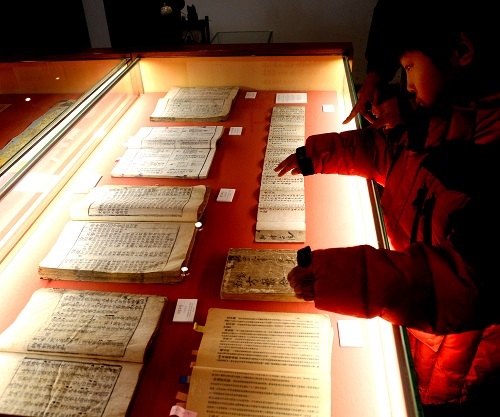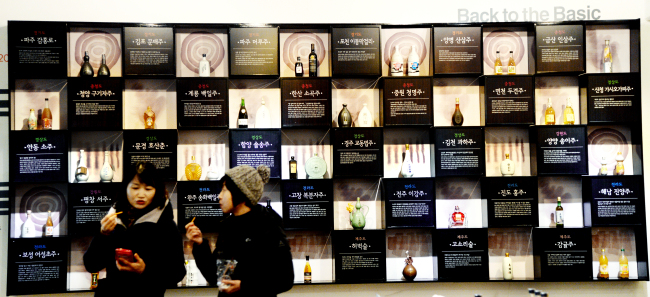Sansawon provides historical look at traditional Korean liquor
By 박형기Published : Jan. 22, 2016 - 10:01
There’s an ancient folktale that tells the story of a monkey who blushed and smiled uncontrollably after gorging on a fermented apple he found on the ground. After a farmer noticed the monkey’s pleasant reaction to eating the old piece of fruit, he wondered if humans could enjoy the same blissful side effect, which led to the invention of alcohol.

“Obviously this is just an entertaining folktale, but I think the story gives people an idea about the very long-standing history of alcohol,” said Lee Saeng-hwan, one of the curators for the Sansawon traditional Korean liquor gallery in Pocheon, Gyeonggi Province.
Located next to Baesangmyun Brewery, which also runs the gallery Sansawon, is dedicated to the history and culture of Korean alcohol, which has a distinct historic home-brewing culture.
The quaint museum -- about a two-hour drive from central Seoul -- exhibits various wooden tools and artifacts that were once used in people’s homes to make rice-based alcoholic drinks for the household and visiting guests.
“The gallery is a brief representation of how our ancestors used to make alcohol,” said Lee, pointing to the array of wooden farm-like tools and storage vats the museum showcases. “You may notice that most of the artifacts that were used to brew liquor back then were not much different from ordinary household utensils because everything was prepared and brewed in the home and not a large factory.”
“Obviously nowadays traditional Korean liquors are mass produced using the latest technology, while for the most part the brewing methods have all been adapted so that the drinks taste similar to the way they did in the past, but there is a saying that the biggest difference between Korean alcohol from the olden days and now is that it no longer ‘tastes of the brewer’s hands,’” Lee says.
“That could be a good or bad thing depending on your viewpoint,” he added with a smile.

Although the country’s most famous alcohol-based beverages are soju and makgeolli, it is estimated that the country has roughly 600 different types of liquor, with some historians claiming that a number of traditional brews were lost following Japan’s colonization of the peninsula.
And while rice is the main ingredient for almost all of the country’s traditional liquors, the way Koreans use yeast is said to provide its greatest distinguishing characteristic from other traditional Asian alcohols, which are also typically rice-based drinks.
“It’s a bit tricky when it comes to comparing and contrasting traditional Korean liquors with alcohol that’s made overseas,” he explained. “It’s not really fair at all to compare Korean liquor to those that are made in the West like Europe because it’s just a completely different process.”
“But in the case of how Korean rice wine like makgeolli differs from Japanese rice wine such as sake, is that we use yeast,” he added. “We use nuruk (a kind of cake containing yeast) to help the fermentation process, and this use of yeast gives makgeolli a distinctive flavor that other Asian alcohols don’t have.”
Also on display at the gallery basement floor is a memorial exhibition entirely dedicated to late Bae Sang-myeon, founder of Kooksoondang Brewery and father of Bae Yeong-Ho, the founder and owner of Baesangmyeon Rice Liquor Brewery.
For those interested in a more interactive approach to their day of educational booze-filled fun, the Sansawon also offers a home brewing class that provide visitors with an opportunity to learn about traditional liquor culture as well as offering guest hands-on tutorials on how to make their own, home-brewed creations (advance reservations are required).
Sansawon opens on weekdays from 8:30 a.m. to 5:30 p.m. with admission cost listed at 2,000 won. For more information, visit www.sansawon.co.kr.
By Julie Jackson (juliejackson@heraldcorp.com)



![[Exclusive] Korean military set to ban iPhones over 'security' concerns](http://res.heraldm.com/phpwas/restmb_idxmake.php?idx=644&simg=/content/image/2024/04/23/20240423050599_0.jpg&u=20240423183955)

![[Graphic News] 77% of young Koreans still financially dependent](http://res.heraldm.com/phpwas/restmb_idxmake.php?idx=644&simg=/content/image/2024/04/22/20240422050762_0.gif&u=)




![[Pressure points] Leggings in public: Fashion statement or social faux pas?](http://res.heraldm.com/phpwas/restmb_idxmake.php?idx=644&simg=/content/image/2024/04/23/20240423050669_0.jpg&u=)








